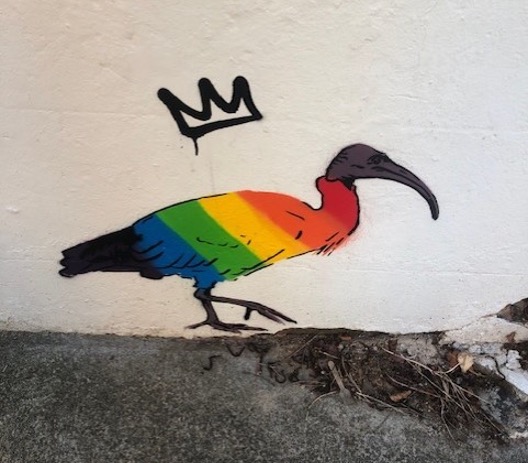Featured in

WHY DO CERTAIN animals seem to magically capture the zeitgeist, invading our dreams and animating our fears and anxieties?
Animals have always played a part in the myths and stories that help us make sense of and order the world around us. But some animals push the boundaries and unsettle this order. They sit on the fence, offering a strange combination of delight and disturbance, anxiety and wonder.
The anthropologist Claude Lévi-Strauss famously wrote that animals become totemic not because they’re ‘good to eat’ but because they’re ‘good to think’. Few animals have captured the popular imagination quite like the Australian white ibis, aka the bin chicken, a species that is not only good to think (about and with) but that also has something to say to us. In March 2021, the Macquarie dictionary selected ‘bin chicken’ as its Aussie Word of the Week, noting, ‘The bin chicken has pecked and scavenged its way into Australian culture.’ The dictionary even dared to suggest that the bin chicken might surpass the kangaroo as Australia’s most iconic animal. It was recognition of the urban journey taken by the ibis, a native species that in a few short years has gained a highly visible presence in many Australian cities as well as its cultural landscape.
THAT URBAN JOURNEY began in the 1970s and 1980s. In this era, the birds were increasingly impelled into cities by drought, the damming of rivers and the related degradation of inland wetlands, most notably across the vast Murray-Darling Basin, which forms the traditional habitat for ibis in eastern Australia. By the early 2000s, ibis were seen as integral to the cityscape of Sydney and other coastal towns. Today, the urban ibis is so ubiquitous that it confronts the assumptions of many Australians that cities are privileged habitats for humans, and wild animals exist elsewhere.
Bold and unfazed by humans, ibis have flourished in cities and assumed a common presence not only in parks and gardens but also in inner-city food courts, schoolyards, streets and laneways, not to mention rubbish tips. As a protected native species, they are free to roam.
They are not unlike the African sacred ibis (a sister species) that was worshipped in Ancient Egypt as the living embodiment of the god Thoth (or Djehuty). Among his many attributes, Thoth was the god of knowledge and wisdom, science and law, writing and language, and magic. Many Australians today regard the Australian white ibis as bearing a similar sacred provenance.
Indeed, while some people see the ibis as a ‘dirty bird’, an opportunistic interloper and trash animal that is out of place in the city, others are inspired by its skilful adaptation, seeing a bird deserving of empathy and respect. Ibis-human adaptation has been a two-way street. The burgeoning visibility of the ibis in popular culture, media and artistic practice is evidence of an unfolding relationship of wonder in which the bin chicken figures as an important locus of affiliation, identification and ironic affection. Whether in a bin chicken mural in an inner-city laneway, a dance performance inspired by the bird’s hypermobile movements, or ibis-themed kaftans, scarves and T-shirts, few other animals in Australia have gained the kind of cultural attention and notoriety that the Australian white ibis has.
While often playful and ironic, the bin chicken phenomenon has a more serious side. Like an ‘animal familiar’, the humble ibis is helping us navigate changing times, including the question of who belongs and who does not in modern Australia. A vast array of bin chicken merch celebrates a decidedly kitsch Aussie aesthetic that champions a working-class or bogan sensibility. The idea of the ibis as an Aussie battler – often denigrated but never defeated – is at the heart of this bin chicken aesthetic. It is affectionately splashed across fluffy slippers, a ‘glamour sack dress’, tea towels and coffee mugs.
The Vietnamese-Australian writer Shirley Le connects the ibis’ mixed reception in Australian cities with human tales of migration, displacement and survival. The cover of Le’s 2023 novel, Funny Ethnics,features an ibis holding a bubble tea. Here the ibis stands in for Sydney’s multicultural western suburbs and symbolises the diasporic experience of Vietnamese postwar migration and marginalisation in their new home. Like the ibis, new arrivals to Australia’s second-largest city are not always made to feel welcome, and their journeys of forced displacement are often not appreciated.
A queer rainbow bin chicken aesthetic has also emerged from within LGBTQI communities, which have adopted the ibis as an animal mascot. A bin chicken float during Mardi Gras playfully assimilated the outsider status of the ibis as a vector for thinking about queer identities and their sociopolitical status.
Some writers see the ibis as what scientist John Martin calls ‘a conservation messenger’, a bird that makes links between habitat loss, climate change and excess human consumption. For authors Kate and Jol Temple, the ibis is the perfect animal through which children can begin to think about adaptation, resilience and sharing habitat with urban wildlife. Their illustrated series of bin chicken children’s books does not gloss over the dirt and grime of ibis adaptation in the urban wild but instead encourages children to reflect on why these birds have had to adapt in the first place, and to appreciate their success in flourishing against the odds. The ibis’ pluckiness, resourcefulness and resilience are qualities that children can learn from. The books foster empathy through a form of cross-species pedagogy in which the bin chicken is an animal teacher.
For some urban residents the ibis taps into deep fears and anxieties, precisely what Melbourne-based artist Mike Seabrook targets to great comic effect in a set of ibis paintings from 2020. Each features a giant ibis that looms, Godzilla-like, over suburban homes or caravans, as bemused suburbanites or terrified holiday-makers look on in disbelief. The paintings comment sardonically on the reputation of the Australian white ibis as an invasive species, a so-called pest, in urban settings across Australia.
DESPITE ITS TRASHY reputation and dumpster-diving ways, the ibis has gained a measure of acceptance over time. Even the term ‘bin chicken’ has shifted from being a negative insult to a more positive term of endearment and in some cases even affection. As Louis Hanson explained on Pedestrian TV in 2019, the bin chicken is ‘a tough nut, and true spirit animal for the masses’.
The burgeoning cultural visibility of this native species attests to a two-way process of adaptation. As the ibis has become urban, many city dwellers have channelled the ibis (as the Gold Coast performance duo Mozart and Coltrane have been doing in their bin chicken costumes since 2011). The rise of the bin chicken challenges not only long-held assumptions about who belongs in the city but also ideas about human exceptionalism, and of cities as spaces of human-centred design and habitation par excellence. Now considered to be a common urban bird, the ibis has important things to say about our human impacts on an environment in which we are merely one species among many.
Image credit: rainbow flag ibis by Scott Marsh, photo by Paul Allatson
Share article
About the author

Andrea Connor
Andrea Connor is a writer and academic working at Western Sydney University. She writes and publishes across the interrelated fields of urban and cultural...